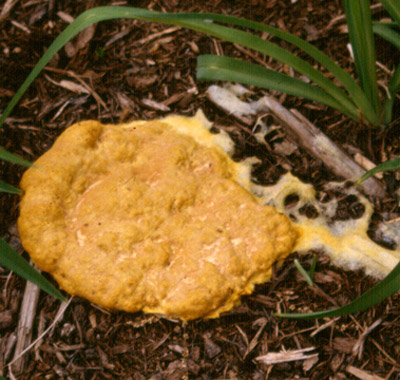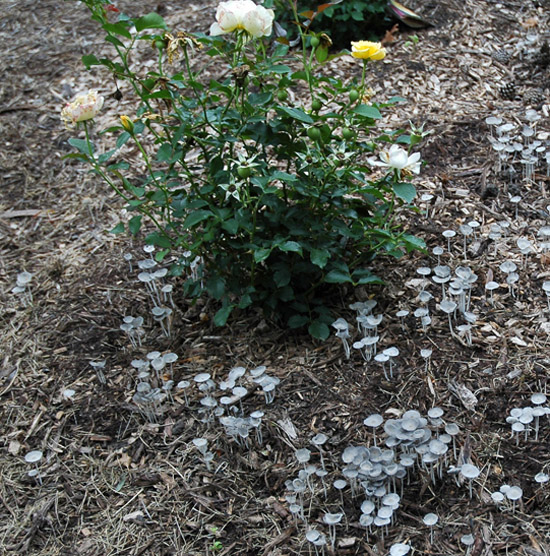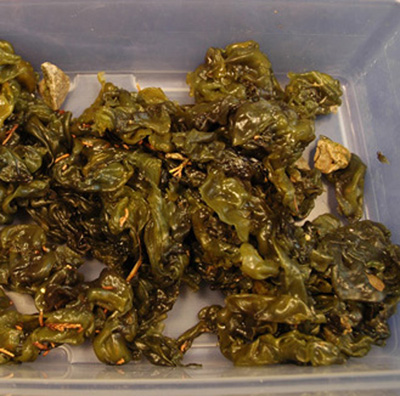Issue 9, June 18, 2010
Slime Molds, Mushrooms, and Algae, Oh My!
Everyone seems to understand the value of landscape mulch. It does, unfortunately, have a few inhabitants that are offensive to people. There are aesthetic problems like slime molds and mushrooms. There are also some health and safety concerns such as mushrooms and algae. Artillery fungi can be costly. Landscape mulch made from wood and bark is wonderful because it decomposes and adds to soil health. Bacteria and fungi help organic matter decompose, so it is only natural that such mulches will sometimes have fungi and bacteria growing in or on them. In wet weather we see some things that may raise questions.
Slime molds feed on decomposing organic matter, and can be found in almost any given spot in the home landscape; sidewalks, mulched areas, wood chips in play areas, or over vegetation such as turf, strawberries, flowers, ground covers, weeds, and the base of woody plants. They will not cause direct harm to your plants or your family. Of course, they should not be eaten.
Slime molds range in color and size, often seeming to appear suddenly after a period of warm, wet weather. They are also commonly found during the summer in irrigated landscapes. The plasmodium, or "feeding" stage, appears as a slimy, amoeba-like organism. Slime molds may be white, gray, yellow (See image by J. Schuster), orange, violet, blue, green, or purple-brown greasy masses and can get as large as one to two feet in diameter. One type of slime mold displays an unpopular resemblance to dog vomit. The plasmodium soon develops colorful, crusty fruiting bodies filled with masses of dusty spores. These organisms do "move", but too slowly to watch. Homeowners are often concerned when, after a day to several days, they notice that the colorful and slimy "blobs" have migrated a short distance. No chemical controls are known, nor needed, to combat slime molds. They usually dry up and disappear in dry weather. If you have some unsightly patches in a garden that you wish to eliminate, simply remove the spore masses in a plastic bag and break up the remaining masses by vigorous raking or brushing.

Mushrooms of various sizes and shapes grow in mulch. Most are harmless to plants but can cause other concerns. Some folks worry that dogs or children might eat them. The image shows some mushrooms in mulch near my roses. They dry up with the weather and have not caused any problems to the plants. Artillery fungi are the tiny structures that "shoot" spores as high as two stories of a home. They can cause black spots on siding that will not wash off. More on artillery fungi can be found at this Cornell University site. Still others give off an offensive odor, like stinkhorns. Stinkhorns are members of the Phallaceae family of fungi. When fresh they will smell terrible, thus the name of stinkhorn. Stinkhorns are saprophytic fungi, meaning they live off dead plant material. They do not parasitize healthy plants. The mycelial phase of the fungus is beneath the finger shaped fruiting structure and grows throughout wood chips, rotting roots, or any organic matter in the soil, helping with decomposition. Stinkhorns are often found in parks, wood chip areas, field crops, and composted soil. They usually appear in wet conditions on fertile soil.

Probably the most asked question is, "How do I get rid of these things?" There is nothing you can do to eradicate these foul smelling fungi. If there were no organic matter there would be no stinkhorns, but then, your landscape would be unattractive since plants need organic matter to thrive.
Algae are simple plantlike organisms ranging in size from microscopic to large seaweeds. They do not have roots and leaves but they do make their own food by photosynthesis. They grow in water or on damp surfaces such as on soil, on animals, and even on the bark of trees. A recent Plant Clinic sample of algae growing on rock is pictured here. The concern was not for plants but for safety. The algae made the rocks very slick in an area frequented by the public.

There are many organic structures that will grow on organic mulch or other landscape materials. Assess the threat of such structures before you worry about how to eradicate them. On a recent trip to Penn State University, I found a publication called "What is Growing in My Landscape Mulch?" (Adobe PDF) This publication has some nice images of problems we see on mulch each year.--Nancy Pataky